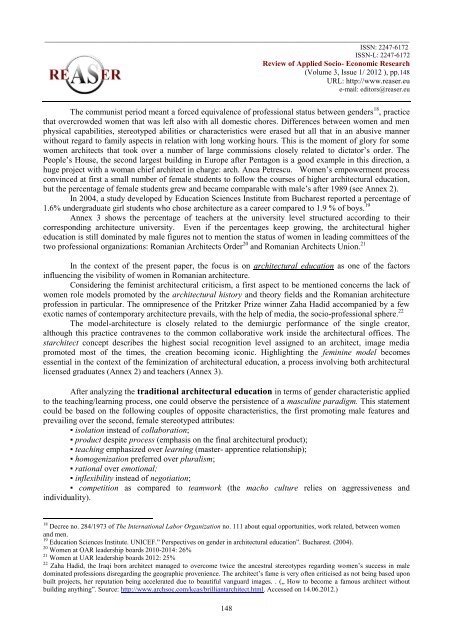Volume 3, ISSUE1/2012 - Review of Applied Socio-Economic ...
Volume 3, ISSUE1/2012 - Review of Applied Socio-Economic ...
Volume 3, ISSUE1/2012 - Review of Applied Socio-Economic ...
Create successful ePaper yourself
Turn your PDF publications into a flip-book with our unique Google optimized e-Paper software.
________________________________________________________________________________________________<br />
ISSN: 2247-6172<br />
ISSN-L: 2247-6172<br />
<strong>Review</strong> <strong>of</strong> <strong>Applied</strong> <strong>Socio</strong>- <strong>Economic</strong> Research<br />
(<strong>Volume</strong> 3, Issue 1/ <strong>2012</strong> ), pp.148<br />
URL: http://www.reaser.eu<br />
e-mail: editors@reaser.eu<br />
The communist period meant a forced equivalence <strong>of</strong> pr<strong>of</strong>essional status between genders 18 , practice<br />
that overcrowded women that was left also with all domestic chores. Differences between women and men<br />
physical capabilities, stereotyped abilities or characteristics were erased but all that in an abusive manner<br />
without regard to family aspects in relation with long working hours. This is the moment <strong>of</strong> glory for some<br />
women architects that took over a number <strong>of</strong> large commissions closely related to dictator’s order. The<br />
People’s House, the second largest building in Europe after Pentagon is a good example in this direction, a<br />
huge project with a woman chief architect in charge: arch. Anca Petrescu. Women’s empowerment process<br />
convinced at first a small number <strong>of</strong> female students to follow the courses <strong>of</strong> higher architectural education,<br />
but the percentage <strong>of</strong> female students grew and became comparable with male’s after 1989 (see Annex 2).<br />
In 2004, a study developed by Education Sciences Institute from Bucharest reported a percentage <strong>of</strong><br />
1.6% undergraduate girl students who chose architecture as a career compared to 1.9 % <strong>of</strong> boys. 19<br />
Annex 3 shows the percentage <strong>of</strong> teachers at the university level structured according to their<br />
corresponding architecture university. Even if the percentages keep growing, the architectural higher<br />
education is still dominated by male figures not to mention the status <strong>of</strong> women in leading committees <strong>of</strong> the<br />
two pr<strong>of</strong>essional organizations: Romanian Architects Order 20 and Romanian Architects Union. 21<br />
In the context <strong>of</strong> the present paper, the focus is on architectural education as one <strong>of</strong> the factors<br />
influencing the visibility <strong>of</strong> women in Romanian architecture.<br />
Considering the feminist architectural criticism, a first aspect to be mentioned concerns the lack <strong>of</strong><br />
women role models promoted by the architectural history and theory fields and the Romanian architecture<br />
pr<strong>of</strong>ession in particular. The omnipresence <strong>of</strong> the Pritzker Prize winner Zaha Hadid accompanied by a few<br />
exotic names <strong>of</strong> contemporary architecture prevails, with the help <strong>of</strong> media, the socio-pr<strong>of</strong>essional sphere. 22<br />
The model-architecture is closely related to the demiurgic performance <strong>of</strong> the single creator,<br />
although this practice contravenes to the common collaborative work inside the architectural <strong>of</strong>fices. The<br />
starchitect concept describes the highest social recognition level assigned to an architect, image media<br />
promoted most <strong>of</strong> the times, the creation becoming iconic. Highlighting the feminine model becomes<br />
essential in the context <strong>of</strong> the feminization <strong>of</strong> architectural education, a process involving both architectural<br />
licensed graduates (Annex 2) and teachers (Annex 3).<br />
After analyzing the traditional architectural education in terms <strong>of</strong> gender characteristic applied<br />
to the teaching/learning process, one could observe the persistence <strong>of</strong> a masculine paradigm. This statement<br />
could be based on the following couples <strong>of</strong> opposite characteristics, the first promoting male features and<br />
prevailing over the second, female stereotyped attributes:<br />
▪ isolation instead <strong>of</strong> collaboration;<br />
▪ product despite process (emphasis on the final architectural product);<br />
▪ teaching emphasized over learning (master- apprentice relationship);<br />
▪ homogenization preferred over pluralism;<br />
▪ rational over emotional;<br />
▪ inflexibility instead <strong>of</strong> negotiation;<br />
▪ competition as compared to teamwork (the macho culture relies on aggressiveness and<br />
individuality).<br />
18 Decree no. 284/1973 <strong>of</strong> The International Labor Organization no. 111 about equal opportunities, work related, between women<br />
and men.<br />
19 Education Sciences Institute. UNICEF.” Perspectives on gender in architectural education”. Bucharest. (2004).<br />
20 Women at OAR leadership boards 2010-2014: 26%<br />
21 Women at UAR leadership boards <strong>2012</strong>: 25%<br />
22 Zaha Hadid, the Iraqi born architect managed to overcome twice the ancestral stereotypes regarding women’s success in male<br />
dominated pr<strong>of</strong>essions disregarding the geographic provenience. The architect’s fame is very <strong>of</strong>ten criticised as not being based upon<br />
built projects, her reputation being accelerated due to beautiful vanguard images. . („ How to become a famous architect without<br />
building anything”. Source: http://www.archsoc.com/kcas/brilliantarchitect.html. Accessed on 14.06.<strong>2012</strong>.)<br />
148








